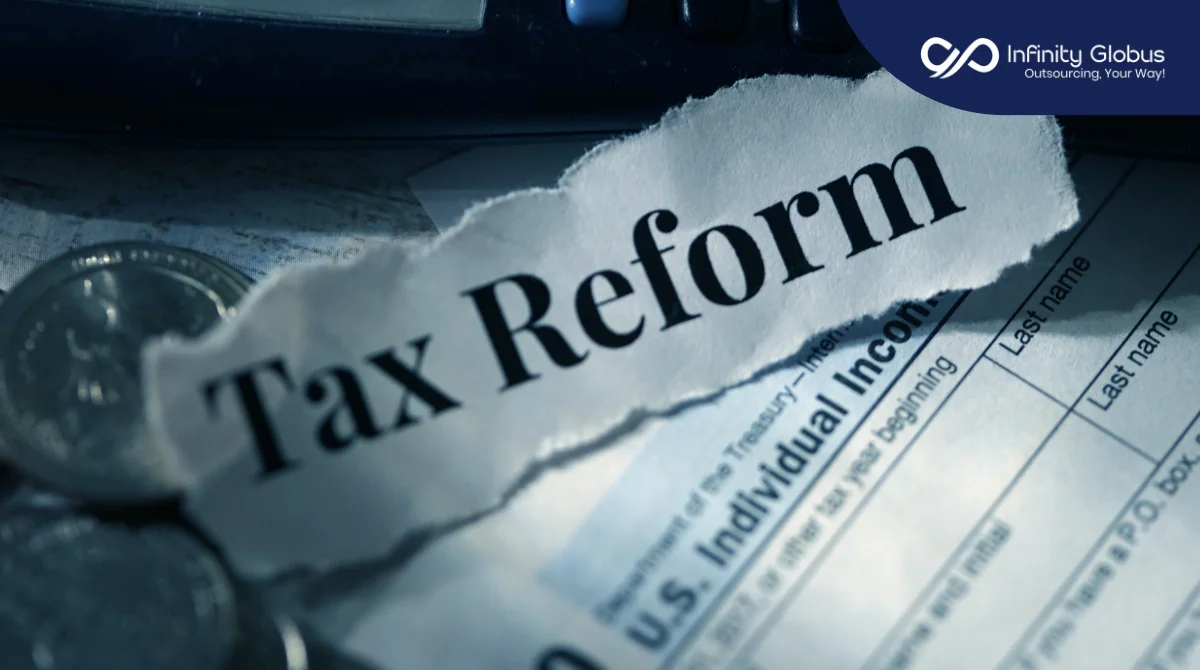
 Infinity Globus
Infinity Globus
 25 Jan 2022
25 Jan 2022
Numerous tax changes were enacted as part of the American Rescue Plan Act, which was signed into law in March 2021. This act was enacted to assist individuals and businesses in coping with the continued economic disruption caused by the COVID-19 epidemic.
Additionally, late in December 2020, additional tax measures were enacted that would affect this filing season. To assist your clients in planning, the following is a summary of the key provisions of recent tax law changes.
1. Economic Impact Payments (EIPs)

The American Rescue Plan Act authorized the distribution of a new round of EIPs to eligible people. As with the stimulus payments made last year, the EIPs were established as advance instalments of a recovery rebate tax credit.
If your clients were eligible for EIPs, they should have already received these payments. However, if the IRS owes them more money, this additional amount will be captured and claimed on their 2021 income tax return. If they got an EIP as an advance payment, the IRS should send them a letter. Maintain this for record-keeping purposes to assist in determining any necessary adjustments.
2. Child Tax Credit
In tax legislation 2021, the ARP greatly enhanced the eligible child tax credit (CTC). The CTC was increased from $2,000 per child (under age 17) in 2020 to $3,000 per child (under age 18) or $3,600 (children younger than 6) for 2021.
The creditable age of a child has been increased from 16 to 17. Additionally, the 2021 CTC’s refundable portion equals the total credit amount, rather than being calculated using an earned income method.
The updated phase-out regulations reduced the modified adjusted gross income level used to determine whether an individual qualifies for the CTC to $150,000 for joint returns or surviving spouses, $112,500 for heads of household, and $75,000 in all other cases.
This unique phase-out decrease is restricted to the smaller of the amount of the applicable credit increment (i.e., $1,000 or $1,600) or 5% of the applicable phase-out threshold range.
Taxpayers who qualify for refundable child tax credits may be eligible for advance credit payments. Beginning in July, the IRS began paying half of the credit in advance through monthly payments.
Some taxpayers elected not to participate, while others may have complexity that requires more investigation.
In terms of stimulus payments and child tax credits, the following is relevant:
- Taxpayers who received Advance Child Tax Credits beginning in December and those who received the third round of Economic Impact Payments will be sent information letters beginning in January by the Internal Revenue Service. A tax return’s accuracy and timeliness can be improved by making use of this data during the preparation process.
- People who received these letters were asked by the IRS to keep them in order to aid them in preparing their federal tax returns for 2022, which are due in 2021.
3. Dependent Care Assistance Tax Benefits
Changes to the tax benefits for dependent care support were made by the ARP, including:
- The child and dependent care tax credit (CDCTC) was made refundable.
- Boost the amount of costs that can be deducted from taxable income in order to qualify for this credit.
- Raise the maximum credit rate.
- Raise the appropriate proportion of expenses that can be deducted.
In general, your client may be eligible for a nonrefundable CDCTC for up to 35% of the cost of paying someone to care for their kid or dependent while they work or look for work. For tax law changes 2021, the dependent care credit is refundable for individuals who spend more than half of the tax year in the United States.
The ARP increased the creditable limit for child and dependent care expenses to $8,000 for one qualifying individual and $16,000 for two or more suitable individuals.
Additionally, the maximum credit rate is increased from 35% to 50%, and phase-out criteria begin at $125,000 in adjusted gross income (i.e., household income). At $125,000, the credit proportion begins to dwindle and eventually reaches 20%.
For taxpayers with an adjusted gross income in excess of $400,000, this 20% credit rate runs out. Additionally, for 2021, the amount of employer-provided dependent care assistance that may be deducted from income has been increased from $5,000 to $10,500 (or from $2,500 to $5,250 in the event of a married individual filing a separate return).
4. Premium Tax Credit
A premium assistance credit is given to qualifying individuals and families who purchase health insurance through the Patient Protection and Affordable Care Act’s insurance exchanges (PPACA). Premium assistance credits are refundable and must be paid directly to the insurer on the exchange in advance.
Individuals earning more than 400% of the federal poverty line are usually ineligible for these subsidies. However, the ARP repealed that condition for tax years beginning in 2021 or 2022, making the subsidy available to anybody.
Additionally, the provision caps the proportion of a person’s income that can be used to pay for health insurance under a PPACA plan at 8.5 percent.
5. Charitable Contribution Deductions
Your clients (individuals) who do not itemize their deductions are eligible to claim a $300 deduction ($600 for joint filers). These gifts must be paid in cash to eligible organizations. Individuals who itemize their taxes may continue to deduct qualified charitable contributions.
Additionally, taxpayers can deduct charitable contributions equal to up to 100% of their adjusted gross income (AGI) in 2021. (This is an increase from 60%).
6. Required Minimum Distributions (RMDs)
RMDs are the minimal annual withdrawals from retirement accounts (e.g., 401(k) or IRA) that your clients must make if they fulfil specific conditions.
For 2021, if they reach the age of 72 at the end of the year (or 701/z if they reach that age before Jan. 1, 2020), they must take a distribution. Planning ahead to assess the tax implications of RMDs is critical, even more so for individuals who are taking their first RMDs.
7. Unemployment Compensation
Another point to remember is that unemployment compensation will be treated differently in 2021. There is no income exclusion. In 2021, the $10,200 income tax deduction that a taxpayer may have received in 2020 will be phased out.
8. Year-End Moves For Your Business
- Make sure your client’s company is eligible for the Employee Retention Credit before applying for it.The Employee Retention Credit is generally available to small businesses that have experienced a significant drop in gross receipts (more than a 20% decrease compared to 2019 or the immediately preceding quarter had a significant drop in gross receipts) or have been subjected to a complete or partial suspension of operations (ERC).In order to receive a 70% tax credit, employees must earn at least $10,000 in qualified wages per quarter. The ERC is still available for wages received in 2020, notwithstanding the higher gross receipts drop threshold and the reduced credit percentage and maximum credit per employee.If your client hasn’t claimed the credit for 2021 and 2020 on their initial taxes, they can do so at this point.
- Maximize the Pass-Through Income Tax Deduction.
When taxable income from all sources exceeds $329,800 for married filing jointly, or $164,000 for all others, a pass-through entity owner may be eligible for a deduction of up to 20% of their qualified business income.Managing taxable income to optimize the deduction is critical for owners of pass-through entities subject to the limits.A 20% deduction can be claimed for eligible REIT dividends and publicly traded partnerships. Sole proprietorships, partnerships, S corporations, and LLCs are considered pass-through companies for this deduction since they are taxed as separate entities from the owners. People, trusts, and estates are the only ones who can claim the deduction.
9. Sales And Use Tax Considerations
Changes in sales and use tax legislation and filing requirements are being implemented across the country in the wake of the Supreme Court’s decision in the case of South Dakota v. Wayfair, Inc. The physical presence threshold, which had been in force for decades, was rejected in 2018 by the U.S. Supreme Court in Wayfair.
In light of this ruling, out-of-state businesses could be required to collect and remit sales tax on transactions into states where they have no physical presence. A growing number of states have enacted economic nexus criteria, requiring firms with no physical presence in the state to collect sales tax on purchases made within the state.
Generally, these thresholds are 200 transactions and/or $100,000-$500,000 in sales, but this varies from state to state. Additionally, the Wayfair decision may have an effect on the concept of tax nexus in general.
10. Other Tax Issues to Consider
- Business meals:
For costs paid for food or beverages provided by a restaurant, the deduction is now 100% (rather than 50% previously). This provision applies to expenses incurred on or after December 31, 2020, and expires at the end of 2022.
- Net operating losses:
If your client incurred big losses between 2018 and 2020, they may be able to carry them back up to five years, which can have a major impact on a prior year with a tax burden.
- Purchases of property and equipment:
Many purchases can be totally written off in the year they are placed into service, thanks to tax-favored alternatives accessible to corporations. Additionally, there are tax-favored criteria that allow qualified improved property to qualify for 15-year depreciation and, hence, 100% first-year bonus depreciation.
- Methods of accounting:
More businesses can benefit from the cash accounting technique. This is advantageous for cash flow management and is often simpler to implement than the accrual method of accounting. There are some requirements, but we can assist you in determining whether your firm might profit.
11. Potential Future Tax Law Changes
President Biden recently unveiled a framework for the Build Back Better Plan, which includes a number of tax proposals. The framework would then need to be transformed into legislation that would pass both the Senate and the House.
A few highlights from the tax provisions in effect at the time this letter was written:
- It extends the expanded child tax credit through 2022.
- The 3.8 percent Net Investment Income Tax is expanded to include active income or gain from trades and businesses, including pass-through LLCs, partnerships, and corporations, for taxpayers with modified adjusted gross income in excess of $500,000 married filing jointly or $400,000 single.
- Credits to limit childcare costs to no more than 7% of income for families earning up to 250 percent of the state’s median income.
- Increased IRS funding for enforcement targets taxpayers earning more than $400,000.
- Increases the cap on state and local income tax deductions from $10,000 to $80,000 for the majority of taxpayers.
- Expanded wash sale rules to include crypto currencies, foreign currencies, and certain commodities.
- Restriction on Roth IRA conversions and prohibition of backdoor Roth IRA conversions
- There will be no change in the ordinary or capital income tax rates for taxpayers earning less than $10.
- There will also be no change to the estate, gift, or generation-skipping transfer amounts or rates.
- There will be no change to the C corporation tax rate.
- There will be no adjustment to the OBI deduction.
As an outsourced accounting firm, we made every effort to compile a list of the 2021 tax law changes that would affect individual and business clients of a CPA and accounting firm. However, if you believe we omitted something, please leave a comment.




